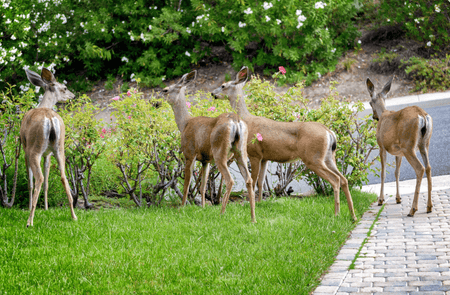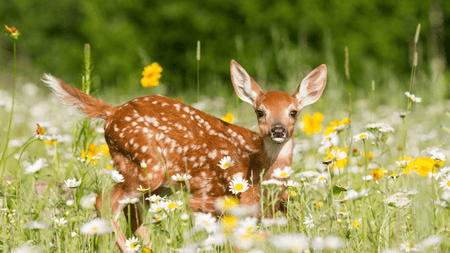Fall Flowers: Native Plants That Bloom and Thrive in Autumn

Warm soil & increased rainfall = happy plants!
While many associate spring and summer with blooming gardens, fall also holds its own magic. Several plants bloom through October, and autumn is actually an excellent time to plant native plants. These native plants play a pivotal role in supporting local wildlife of all kinds as the temperatures begin to drop.

Creating a Fall Native Plant Oasis for Wildlife
In fall, various wildlife species rely on native plants for sustenance and shelter as they prepare for winter. If you have a wildlife garden, you will be supporting:
Pollinators: Bees, butterflies, and hummingbirds are still active in fall, seeking nectar-rich flowers like asters, goldenrods, and cardinal flowers.
Birds: Migratory birds stop by for food on their journey south and non-migratory species need a food supply through the winter.They depend on seeds from wildflowers and berries from trees and shrubs including dogwoods, sumacs, and hollies.
Insects: Insects such as bees, butterflies, and beetles require late-season nectar and foliage. Native plants like goldenrods and asters cater to their needs. Insects such as ladybugs and other predatory beetles help control pest populations and native plants provide them with cover and prey until the frost comes.
Small Mammals: Animals like squirrels, and chipmunks forage for seeds and nuts from native plants like oaks, maples, and sunflowers. Foxes feed on late-season berries from native plants in addition to rodents and birds.
Amphibians and Reptiles: Frogs, lizards and reptiles hide and hunt in dense vegetation as they prepare for their winter dormancy. Plants like sedges, native grasses, and ferns provide shelter near water bodies.
Overwintering Creatures: Many insects, including beneficial predators, lay eggs on or overwinter in or on native plants, ensuring their species’ survival through winter. GARDEN TIP: Another way to help is learning to Leave the leaves if you can in the fall!
Native Plants that Bloom in the Fall
As the days grow shorter and the nights cooler, certain native plants awaken, preparing to showcase their autumnal beauty. These plants are adapted to the changing conditions, and their blooms add a touch of splendor to the landscape. Here are some native plants that shine in the fall:
Goldenrod (Solidago spp.): With brilliant yellow plumes, goldenrod is a quintessential fall-blooming plant. Contrary to popular belief, goldenrod does not cause allergies; it's actually ragweed that is the culprit. Goldenrod is a vital nectar source for pollinators before winter arrives.
Asters (Symphyotrichum spp.): Asters are a diverse group of native plants that provide a stunning array of colors, from purple and blue to pink and white. They offer a late-season buffet for pollinators and contribute to the overall visual tapestry of autumn gardens. New England aster is on popular species, renowned for their prolific purple flowers, but there are asters native almost everywhere.
Joe-Pye Weed (Eutrochium spp.): Named after a Native American herbalist, Joe-Pye weed boasts large, dome-shaped clusters of pink or purple flowers. These blooms attract butterflies and other pollinators, making it an essential component of a fall wildlife garden.
Cardinal Flower (Lobelia cardinalis): a fantastic choice for fall wildlife support. Its vibrant red blooms attract pollinators, providing late-season nectar. Additionally, its dense foliage offers shelter for various wildlife, making it a valuable addition to any wildlife-friendly garden.
Anise Hyssop (Agastache spp.):There are several species of this attractive purple-blooming native wildflower found across the US that bloom into early fall. They are an absolute pollinator magnet.
Sunflowers (Helianthus spp.): These sunny yellow wildflowers start blooming in summer and keep going ‘til fall, providing nectar for pollinators before they form seeds that sustain birds and other mammals into winter.
Why Fall is a Good Time to Plant Native Plants
 Fall is often underestimated as a planting season, overshadowed by the popularity of spring. However, there are several compelling reasons why autumn is an excellent time to introduce native plants into your garden:
Fall is often underestimated as a planting season, overshadowed by the popularity of spring. However, there are several compelling reasons why autumn is an excellent time to introduce native plants into your garden:
Cooler Temperatures and Consistent Rainfall: Fall's mild temperatures and ample rainfall create optimal conditions for establishing new plants. Cooler air reduces stress on plants, allowing them to develop strong root systems before winter sets in.
Root Growth Focus: During fall, plants prioritize root growth over top growth. Planting in the fall allows roots to establish themselves in the soil, resulting in healthier and more resilient plants come spring.
Less Watering Required: Cooler temperatures mean plants require less water compared to the hot days of summer. This makes fall planting more convenient and environmentally friendly.
Reduced Risk of Transplant Shock: The transition to a garden can be challenging for plants. Fall's mild conditions minimize the risk of transplant shock, enabling plants to settle in more comfortably.
Time to Plan and Prepare: Fall planting allows you to assess your garden's needs, plan your design, and make informed decisions about plant placement. As you observe your garden's changing conditions, you can ensure that your new additions will thrive.
Autumn Investment for a Spring Showcase
After completing your Fall Garden Checklist, take some time to really look around your garden and consider where you can add (or divide) for even more impact. What is working? What is missing?
Fall planting NOW is a gift to your garden's future. The investment you make now will yield rewards as your garden wakes up in the coming spring. Check out our native plant collection for Fall.

Find Native Plants by Zip Code
We took the guesswork out of planting native. Check your zip to see what ships!




















